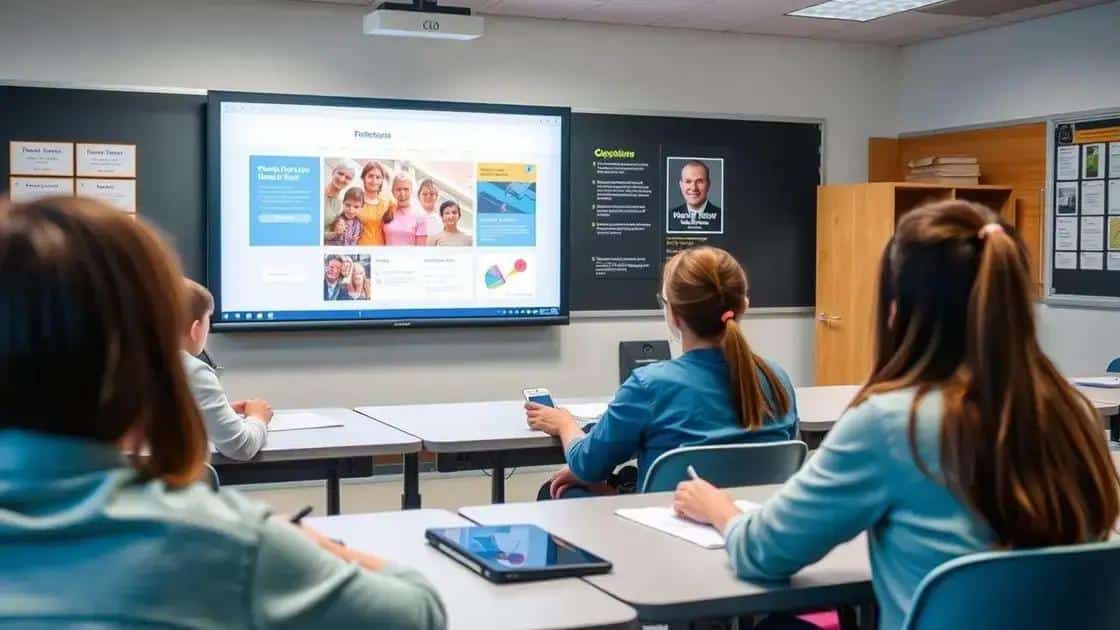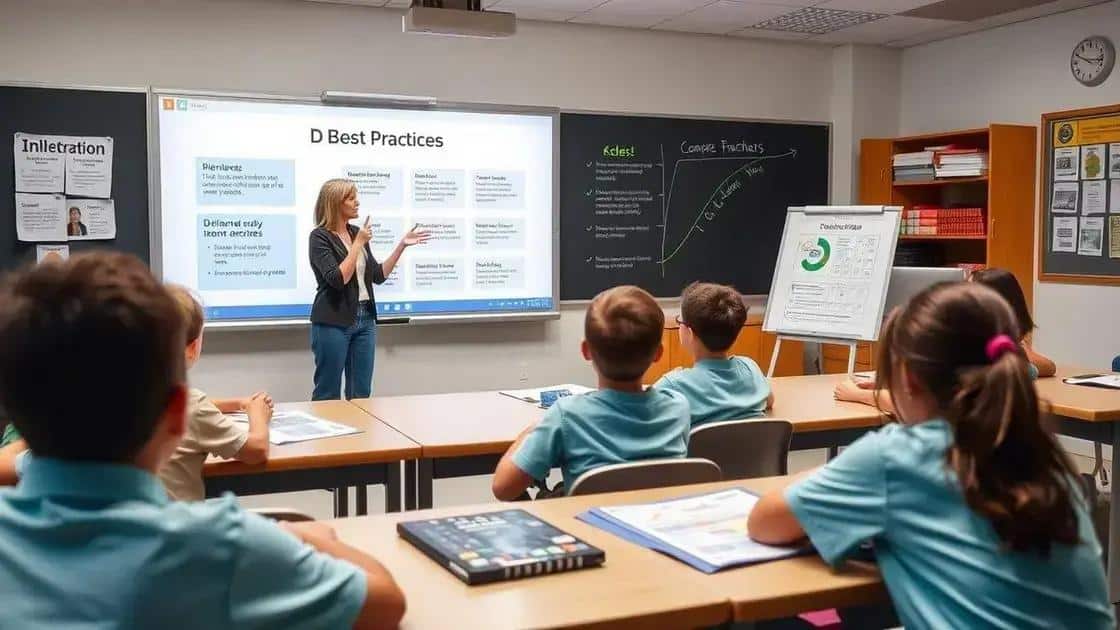Board digital classroom best practices for effective learning

Digital boards in classrooms enhance student engagement, promote collaboration, and accommodate diverse learning styles, making them essential tools for modern education.
Board digital classroom best practices can truly transform the way we approach education. Ever wondered how these tools can enhance learning? Let’s dive into strategies that make digital boards effective.
Understanding digital boards in classrooms
Understanding digital boards in classrooms is essential for modern education. These tools are not just replacements for traditional chalkboards; they enhance learning in significant ways. Digital boards allow teachers to present information dynamically, making lessons more engaging and interactive.
What are Digital Boards?
Digital boards, often referred to as interactive whiteboards, are large display screens that connect to computers and allow for touchscreen interactions. They provide various features like drawing, annotating, and presenting multimedia content.
Benefits of Using Digital Boards
- Enhanced Engagement: Students are more likely to pay attention when lessons are interactive.
- Visual Learning: Complex concepts can be visualized with animations and videos.
- Collaboration: Students can work together on tasks and share their ideas instantly.
By incorporating digital boards into the classroom, teachers can facilitate a more interactive learning environment. These boards can also be used to accommodate students with different learning styles. For instance, visual learners benefit from graphic content, while kinesthetic learners engage through interactive activities.
Moreover, teachers can use software tools that enhance the functionality of digital boards. These tools often include features for real-time quizzes and polls. This capability keeps students involved and provides immediate feedback to both teachers and students.
Challenges to Consider
While the benefits are clear, it’s important to recognize challenges as well. Not all educators are trained to use digital boards effectively, which can lead to underutilization of their features. Additionally, there may be technical issues that disrupt lessons if proper support is not in place.
Overall, understanding how to integrate digital boards into everyday teaching practices is crucial for maximizing their potential. Teachers who harness the full capabilities of these boards can create a more engaging and effective learning experience for their students.
Benefits of digital classroom boards
The benefits of digital classroom boards are significant and can transform the educational experience. These tools not only make lessons more interactive but also cater to diverse learning styles. By employing digital boards, teachers can engage students in ways that traditional methods cannot.
Interactive Learning
One of the main advantages is the ability for students to interact directly with the content. Digital boards allow for real-time participation, making learning a collaborative endeavor. Students can come up to the board to solve problems or contribute ideas, fostering a sense of community.
Visual Aids
- Enhanced Retention: Visual elements help students remember information better.
- Diverse Formats: Teachers can use videos, images, and animations to explain concepts.
- Immediate Feedback: Real-time quizzes can be conducted to gauge understanding instantly.
These visual aids can make complex subjects more accessible. When a student sees a concept represented visually, it can clarify their understanding. Imagine a math lesson where equations are animated, helping students grasp the steps to solve them. This method can lead to greater enthusiasm for learning.
Furthermore, digital classroom boards enable teachers to tailor their lessons to fit the needs of different learners. By incorporating various multimedia resources, educators can appeal to visual, auditory, and kinesthetic learners all at once. This flexibility can significantly enhance student engagement and motivation.
Collaboration Opportunities
Using digital boards also promotes collaboration among students. Group projects can be displayed on the board, allowing students to share their work with the class. This way, peer feedback can occur in real-time, enhancing critical thinking and communication skills.
The integration of online resources is another advantage of these boards. Teachers can quickly pull up articles, videos, or educational games to enrich their lessons. This capability saves time and supports a more dynamic classroom atmosphere. Students can also be encouraged to contribute their findings, taking ownership of their learning process.
Best practices for using digital boards

Using digital boards effectively involves understanding some best practices to maximize their impact in the classroom. These practices help teachers create an engaging and productive learning environment. By following these guidelines, educators can make the most out of this powerful technology.
Preparation is Key
Before a lesson, teachers should prepare the content they will display on the digital board. Having clear objectives and materials ready helps keep the lesson focused. This preparation also ensures that teachers can smoothly transition between different activities without losing the class’s attention.
Encourage Student Interaction
One of the biggest advantages of digital boards is their ability to promote interaction. Teachers should encourage students to come up to the board to answer questions or contribute ideas. This engagement can make learning more dynamic and exciting. Additionally, using tools like polls or quizzes in real time can involve every student and foster collaboration.
- Use Varied Media: Incorporate images, videos, and animations to cater to various learning styles.
- Facilitate Group Work: Have students work in pairs or small groups at the board to solve problems together.
- Provide Immediate Feedback: Use interactive features to give students instant responses during activities.
By valuing interaction, educators can create a classroom atmosphere where students feel comfortable expressing their opinions and asking questions. When students actively participate, they retain information better and feel more connected to the subject matter.
Keep Content Clear and Concise
When displaying information on a digital board, it is essential to keep the content clear and concise. Overloading the board with text can overwhelm students and make key points hard to remember. Instead, teachers should use bullet points or short sentences and highlight critical concepts with color or bold text. This method helps maintain students’ focus on the most important parts of the lesson.
Additionally, regularly checking for understanding can help adjust the pacing of the lesson. Asking students questions to gauge their comprehension can provide valuable feedback on the effectiveness of the teaching methods being used.
Engaging students with digital tools
Engaging students with digital tools is essential for promoting active learning in today’s classrooms. These tools can boost interaction, enhance creativity, and help students take ownership of their learning. By using technology wisely, teachers can create an exciting and dynamic educational environment.
Utilizing Interactive Software
Many digital tools provide interactive features that keep students involved. For example, platforms like Kahoot and Quizizz allow educators to create fun quizzes that students can answer using their devices. This interactivity encourages friendly competition and reinforces learning in a playful way.
Promoting Collaborative Learning
Digital tools also foster collaboration among students. Using platforms such as Google Docs or Padlet, students can work together on projects in real-time. This kind of teamwork not only improves communication skills but also promotes critical thinking as students share and refine their ideas.
- Peer Reviews: Students can offer feedback to each other on assignments.
- Group Projects: Collaborative work becomes easier with shared digital resources.
- Brainstorming Sessions: These tools can support brainstorming and group discussions efficiently.
Moreover, facilitating collaboration through digital platforms allows students to engage with their peers from different backgrounds. This enhanced interaction can lead to a deeper understanding of diverse perspectives.
Incorporating Multimedia Content
Using multimedia content is another effective way to engage students. Videos, podcasts, and interactive presentations can bring subjects to life, making them more relatable. For instance, incorporating educational videos relevant to the lesson helps appeal to visual learners, while podcasts can support auditory learners.
Handling multimedia is easy with today’s digital tools. Teachers can access a wealth of resources online, adding variety to their lessons and keeping students interested. By introducing elements like animations or simulations, teachers can make complex topics more understandable and entertaining.
Evaluating the effectiveness of digital boards
Evaluating the effectiveness of digital boards is crucial for understanding their impact on student learning. It is important to measure how well these tools facilitate engagement, understanding, and retention of information. By assessing their effectiveness, teachers can make data-driven decisions on how to improve their teaching methods.
Monitoring Student Engagement
One way to evaluate the effectiveness of digital boards is by monitoring student engagement during lessons. Teachers can observe how often students participate in discussions or interact with the board. Are students eager to come up and share their ideas? Engagement can indicate that the digital board is being used effectively.
Assessing Learning Outcomes
Another key factor is assessing learning outcomes. Teachers should compare student performance on tests and quizzes before and after implementing digital boards in their lessons. Are scores improving? This data can show whether the use of technology is enhancing learning.
- Feedback Forms: Collect student feedback on the lessons.
- Observation: Conduct regular observations to note engagement levels.
- Performance Tracking: Analyze grades over time to track progress.
In addition to analyzing test results, teachers can use formative assessments to gather immediate feedback on understanding. Using interactive elements on the digital boards, like quick polls, can provide real-time insights into how well students grasp the material. This instant feedback can guide the pace and direction of the lesson.
Gathering Teacher Insights
Teacher reflections can also be valuable. After lessons, instructors can take notes about what worked well and what didn’t. Reflecting on the effectiveness of digital boards helps educators continuously improve their practices. Discussion among colleagues about shared experiences can lead to new ideas and strategies for engaging students.
By combining various evaluation methods, teachers can paint a comprehensive picture of the effectiveness of digital boards. This information not only helps improve individual teaching practices but also contributes to school-wide initiatives aimed at improving educational technology integration.
FAQ – Frequently Asked Questions about Digital Boards in Classrooms
What are the main benefits of using digital boards in the classroom?
Digital boards enhance student engagement, promote collaboration, and allow for diverse learning styles through interactive multimedia content.
How can teachers assess the effectiveness of digital boards?
Teachers can evaluate their effectiveness by monitoring student engagement, assessing learning outcomes, and gathering feedback from both students and colleagues.
What are some best practices for using digital boards?
Best practices include preparing content in advance, encouraging student interaction, maintaining clarity in displayed information, and fostering a collaborative environment.
How can digital tools support diverse learning styles?
Digital tools can cater to various learning preferences by incorporating visual, auditory, and kinesthetic resources, making lessons more inclusive and effective.






